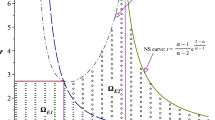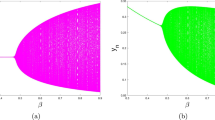Abstract
This paper concerns the reaction–diffusion systems modeling the population dynamics of two predators and one prey with nonlinear prey-taxis. We first investigate the global existence and boundedness of the unique classical solution for the general model. Then, we study the global stabilities of nonnegative spatially homogeneous equilibria for an explicit system with type I functional responses and density-dependent death rates for the predators and logistic growth for the prey. Moreover, the convergence rates are also established.
Similar content being viewed by others
References
Ainseba, B.E., Bendahmane, M., Noussair, A.: A reaction–diffusion system modeling predator–prey with prey-taxis. Nonlinear Anal. RWA 9, 2086–2105 (2008)
Amann, H.: Dynamic theory of quasilinear parabolic equations II. Reaction–diffusion systems. Differ. Integral Equ. 3(1), 13–75 (1990)
Bai, X., Winkler, M.: Equilibration in a fully parabolic two-species chemotaxis system with competitive kinetics. Indiana Univ. Math. J. 65, 553–583 (2016)
Barbălat, I.: Systèmes d’équations différentielles d’oscillations non linéaires. Rev. Math. Pures Appl. 4, 267–270 (1959)
Bellomo, N., Bellouquid, A., Tao, Y., Winkler, M.: Toward a mathematical theory of Keller–Segel models of pattern formation in biological tissues. Math. Mod. Methods Appl. Sci. 25(9), 1663–1763 (2015)
Black, T., Lankeit, J., Mizukami, M.: On the weakly competitive case in a two-species chemotaxis model. IMA J. Appl. Math. 81, 860–876 (2016)
Grünbaum, D.: Advection–diffusion equations for generalized tactic searching behaviours. J. Math. Biol. 38, 169–194 (1999)
He, X., Zheng, S.: Global boundedness of solutions in a reaction–diffusion system of predator–prey model with prey-taxis. Appl. Math. Lett. 49, 73–77 (2015)
Horstmann, D., Winkler, M.: Boundedness versus blow-up in a chemotaxis system. J. Differ. Equ. 215(1), 52–107 (2005)
Jin, H., Wang, Z.: Global stability of prey-taxis systems. J. Differ. Equ. 262, 1257–1290 (2017)
Kareiva, P., Odell, G.T.: Swarms of predators exhibit “preytaxis” if individual predators use area-restricted search. Am. Nat. 130, 233–270 (1987)
Ladyzenskaja, O.A., Solonnikov, V.A., Ural’ceva, N.N.: Linear and Quasi-Linear Equations of Parabolic Type. Academic Press, New York (1968)
Lee, J.M., Hillen, T., Lewis, M.A.: Pattern formation in prey-taxis systems. J. Biol. Dyn. 3(6), 551–573 (2009)
Lin, K., Mu, C.: Convergence of global and bounded solutions of a two-species chemotaxis model with a logistic source. Discrete Contin. Dyn. Syst.-Ser. B 22, 2233–2260 (2017)
Lin, J., Wang, W., Zhao, C., Yang, T.: Global dynamics and traveling wave solutions of two predators-one prey models. Discrete Contin. Dyn. Syst.-Ser. B 20, 1135–1154 (2015)
Loladze, I., Kuang, Y., Elser, J.J., Fagan, W.F.: Competition and stoichiometry: coexistence of two predators on one prey. Theo. Popul. Biol. 65, 1–15 (2004)
Mizukami, M.: Boundedness and asymptotic stability in a two-species chemotaxis-competition model with signal-dependent sensitivity. Discrete Contin. Dyn. Syst. B 22(6), 2301–2319 (2017)
Pang, P., Wang, M.X.: Strategy and stationary pattern in a three-species predator–prey model. J. Differ. Equ. 200, 245–273 (2004)
Sapoukhina, N., Tyutyunov, Y., Arditi, R.: The role of prey taxis in biological control: a spatial theoretical model. Am. Nat. 162, 61–76 (2003)
Stinner, C., Tello, J.I., Winkler, M.: Competitive exclusion in a two-species chemotaxis model. J. Math. Biol. 68, 1607–1626 (2014)
Tao, Y.: Boundedness in a chemotaxis model with oxygen consumption by bacteria. J. Math. Anal. Appl. 381(2), 521–529 (2011)
Tao, Y.: Global existence of classical solutions to a predator–prey model with nonlinear prey-taxis. Nonlinear Anal. RWA 11(3), 2056–2064 (2010)
Tao, Y., Wang, Z.: Competing effects of attraction versus repulsion in chemotaxis. Math. Mod. Methods Appl. Sci. 23(1), 1–36 (2012)
Tello, J.I., Winkler, M.: A chemotaxis system with logistic source. Commun. Part. Differ. Equ. 32, 849–877 (2007)
Tello, J.I., Winkler, M.: Stabilization in a two-species chemotaxis system with a logistic source. Nonlinearity 25, 1413–1425 (2012)
Tona, T., Hieu, N.: Dynamics of species in a model with two predators and one prey. Nonlinear Anal. 74, 4868–4881 (2011)
Wang, J.P., Wang, M.X.: The diffusive Beddington–DeAngelis predator–prey model with nonlinear prey-taxis and free boundary. arXiv:1711.04229 [math.AP]
Wang, K., Wang, Q., Yu, F.: Stationary and time-periodic patterns of two-predator and one-prey systems with prey-taxis. Discrete Contin. Dyn. Syst. 37(1), 505–543 (2017)
Wang, M.X.: A diffusive logistic equation with a free boundary and sign-changing coefficient in time-periodic environment. J. Funct. Anal. 270(2), 483–508 (2016)
Wang, X., Wang, W., Zhang, G.: Global bifurcation of solutions for a predator–prey model with prey-taxis. Math. Methods Appl. Sci. 38, 431–443 (2015)
Winkler, M.: Absence of collapse in a parabolic chemotaxis system with signal-dependent sensitivity. Math. Nachr. 283, 1664–1673 (2010)
Winkler, M.: Boundedness in the higher-dimensional parabolic–parabolic chemotaxis system with logistic source. Commun. Part. Differ. Equ. 35, 1516–1537 (2010)
Wu, S., Shi, J., Wu, B.: Global existence of solutions and uniform persistence of a diffusive predator-prey model with prey-taxis. J. Differ. Equ. 260, 5847–5874 (2016)
Author information
Authors and Affiliations
Corresponding author
Additional information
This work was supported by NSFC Grants 11771110 and 11371113.
Rights and permissions
About this article
Cite this article
Wang, J., Wang, M. Boundedness and global stability of the two-predator and one-prey models with nonlinear prey-taxis. Z. Angew. Math. Phys. 69, 63 (2018). https://doi.org/10.1007/s00033-018-0960-7
Received:
Revised:
Published:
DOI: https://doi.org/10.1007/s00033-018-0960-7




